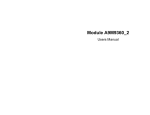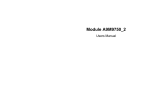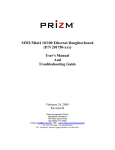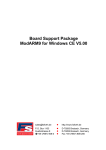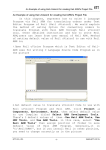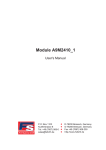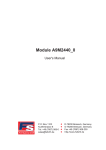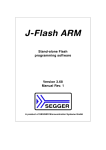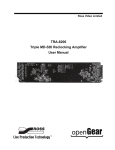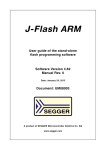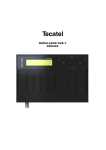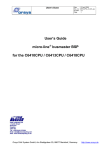Download Module CC9P9360_2 Users Manual
Transcript
Module CC9P9360_2 Users Manual Module CC9P9360_2 Users Manual Copyright 2005: FS Forth-Systeme GmbH, a DIGI Company Postfach 1103, 79200 Breisach, Germany Release of Document: Filename: Author: Program Version January 17, 2006 UM_Module_CC9P9360_2.doc Karl Rudolf All rights reserved. No part of this document may be copied or reproduced in any form or by any means without the prior written consent of FS Forth-Systeme GmbH. Karl Rudolf, 17. January 2006 - Page 2/33 -\\192.168.40.10\projekte\modarm9\a9m9360\doc\um_module_cc9p9360 Module CC9P9360_2 Users Manual Table of Contents 1. Revision History.......................................................................................................................5 2. General ....................................................................................................................................6 2.1. Common Features.........................................................................................................6 2.2. Differences between A9M9750 and A9M9360 Modules ...............................................7 2.3. Existing Variants of A9M9360_1 ...................................................................................8 2.4. Existing Variants of A9M9360_2 ...................................................................................8 3. Detailed Description.................................................................................................................9 3.1. Size 60 x 44 mm............................................................................................................9 3.2. 2 x 120-pin Connectors .................................................................................................9 3.3. NS9360 CPU .................................................................................................................9 3.4. Configuration Pins CPU.................................................................................................9 3.5. Configuration Pins Module ..........................................................................................10 3.6. Clock Generation.........................................................................................................12 3.7. Boot Process ...............................................................................................................13 3.8. Chip Selects, Memory Map .........................................................................................13 3.9. NAND Flash.................................................................................................................13 3.10.1..2 * 16/64 MBytes SDRAM.......................................................................................15 3.11.Usage of 2nd SDRAM bank .........................................................................................15 3.12.73 GPIO Pins (multiplexed with other Functions) .......................................................16 3.13.External Interrupts.......................................................................................................20 3.14.10/100Mbps Ethernet Port ..........................................................................................20 3.15.USB 2.0 full and low speed Host and Device Controller .............................................20 3.16.UART Channels ..........................................................................................................20 3.17.SPI Channels ..............................................................................................................21 3.18.Usage UART and SPI on A9M9360 Module ...............................................................21 3.19.Baudrate Table............................................................................................................22 3.20.I²C Bus ........................................................................................................................22 3.21.LCD Controller (STN & TFT).......................................................................................23 3.22.Serial EEPROM for storing Configuration Parameters ...............................................23 3.23.RTC.............................................................................................................................23 3.24.JTAG, Boundary Scan ................................................................................................23 3.25.Single 3.3V Power Supply; Power Sequencing ..........................................................24 4. Bootloader .............................................................................................................................25 5. Software.................................................................................................................................25 5.1. Software Hints .............................................................................................................25 6. Mechanics..............................................................................................................................26 6.1. Extended Module.........................................................................................................27 7. Known Faults and Limitations................................................................................................29 7.1. SDRAM Clocks: Clockout1-3 not switchable...............................................................29 7.2. I2C: Setup Time Data always half low time of Clock ...................................................29 7.3. SPI Boot System needs Hardware Workaround .........................................................29 8. Appendix................................................................................................................................30 8.1. Pinning Module............................................................................................................30 8.2. Pinning Description Module.........................................................................................30 8.3. Pinning Module on A9MVali Validation Board .............................................................30 8.4. Pinning Module on Development Board ......................................................................30 Karl Rudolf, 17. January 2006 - Page 3/33 -\\192.168.40.10\projekte\modarm9\a9m9360\doc\um_module_cc9p9360 Module CC9P9360_2 Users Manual 9. History....................................................................................................................................33 10. Introduction ............................................................................................................................33 11. References ............................................................................................................................33 12. Features.................................................................................................................................33 13. Detailed Specification ............................................................................................................33 13.1.Technology..................................................................................................................33 13.2.Mechanical Requirements...........................................................................................33 13.3.Block Diagram.............................................................................................................33 14. Board Connectors..................................................................................................................33 Karl Rudolf, 17. January 2006 - Page 4/33 -\\192.168.40.10\projekte\modarm9\a9m9360\doc\um_module_cc9p9360 Module CC9P9360_2 Users Manual 1. Revision History 2005-03-09 (V1.00) KR: Initial Version, derived from A9M9360_1 spec 2005-04-05 (V1.00) KR: Transfer to standard document format 2005-05-30 (V1.00) KR: Migration to A9M9360_2 Karl Rudolf, 17. January 2006 - Page 5/33 -\\192.168.40.10\projekte\modarm9\a9m9360\doc\um_module_cc9p9360 Module CC9P9360_2 Users Manual 2. General A9M9360 Module is a member of the ModARM9 family with a NetSilicon NS9360 CPU. The ModARM9 family includes several modules with the same size, connectors and a set of common pins and functions (see “Arm9 module pinning table.xls”) with CPUs from different manufacturers. There are two modules with Netsilicon CPUs in this family available: A9M9750 and A9M9360. 2.1. Common Features Below are the common features of this module, which will be covered in further detail later in the document. • ARM9 core with MMU • Size 60mm x 44mm with 240-pin connectors • SDRAM 16MB – 256MB • NAND Flash 32MB – 256MB • 4 Serial RS232 interfaces • Host and device USB interface, USB2.0 compliant • 10/100Mbps Ethernet interface • I²C interface, 100KHz and 400KHz • SPI interfaces • JTAG interface Karl Rudolf, 17. January 2006 - Page 6/33 -\\192.168.40.10\projekte\modarm9\a9m9360\doc\um_module_cc9p9360 Module CC9P9360_2 Users Manual 2.2. Differences between A9M9750 and A9M9360 Modules Netsilicon CPU NS9360 is a low cost version of the NS9750. It has many features from the NS9750 including CPU core and most peripherals. Differences: 1. CPU clock is 100..177MHz (NS9750 up to 200MHz) 2. Two SDRAM banks allowing up to 2 * 256MByte memory. 3. No PCI (CardBus) on A9M9360. All pins used by PCI on A9M9750 are unconnected on A9M9360. 4. NS9360 has 73 GPIOs multiplexed with other functions (NS9750 has 50). The same number of GPIOs are available on the A9M9360 connectors as the A9M9750 provides (GPIO0..48). Additional GPIO66..72 are available too, but have non GPIO function names (A22..A25, I2C_SCL, I2C_SDA, WAIT#) and will be used normally in this function. 5. LCD function limited to 18bit LCD data. LCD adapters with 18bit TFT LCD used for A9M9750 will run with A9M9360 too. 6. Dedicated I2C pins IIC_SDA and IIC_SCK on A9M9750 can be GPIO70,71 or A26, A27 on A9M9360 also. 7. 8 timers on A9M9360 (16 on A9M9750). 8. 4 PWM channels added on A9M9360 (each uses 2 timers). 9. Additional USB device modul on A9M9360, needs external USB PHY connected to GPIO42..48. Karl Rudolf, 17. January 2006 - Page 7/33 -\\192.168.40.10\projekte\modarm9\a9m9360\doc\um_module_cc9p9360 Module CC9P9360_2 Users Manual 2.3. Existing Variants of A9M9360_1 Current state (02/2005): 1. 0381: CPU speed 177MHz, 16MByte SDRAM, 32MByte NAND flash, 8KByte SPI boot EEPROM, 8KByte I2C EEPROM, RTC, 0..70° 2. 0382: CPU speed 177MHz, 32MByte SDRAM, 32MByte NAND flash, 8KByte SPI boot EEPROM, 8KByte I2C EEPROM, RTC, 0..70° 3. 0383: CPU speed 177MHz, 64MByte SDRAM, 64MByte NAND flash, 8KByte SPI boot EEPROM, 8KByte I2C EEPROM, RTC, 0..70° Due to a bug in the NS9360 CPU the module generation A9M9360_1 is stopped. A safe start in SPI boot mode needs a hardware workaround realised in A9M9360_2 2.4. Existing Variants of A9M9360_2 Current state (05/2005): 4. 0381: CPU speed 177MHz, 16MByte SDRAM, 32MByte NAND flash, 8KByte SPI boot EEPROM, 8KByte I2C EEPROM, RTC, 0..70° 5. 0382: CPU speed 177MHz, 32MByte SDRAM, 32MByte NAND flash, 8KByte SPI boot EEPROM, 8KByte I2C EEPROM, RTC, 0..70° 6. 0383: CPU speed 177MHz, 64MByte SDRAM, 64MByte NAND flash, 8KByte SPI boot EEPROM, 8KByte I2C EEPROM, RTC, 0..70° Karl Rudolf, 17. January 2006 - Page 8/33 -\\192.168.40.10\projekte\modarm9\a9m9360\doc\um_module_cc9p9360 Module CC9P9360_2 Users Manual 3. Detailed Description 3.1. Size 60 x 44 mm The A9M9360 module has a size of 60 X 44 mm. 3.2. 2 x 120-pin Connectors Two 120-pin connectors on the long side of the module allow accessing most signals of the NetSilicon NS9360 CPU. An optional extension with another two 60-pin connectors is planned. This will extend the length of the module from 60mm to approximately 95mm. Pin-compatible in power supply and main port functions to other ModARM9 modules. 3.3. NS9360 CPU For details see “9360_HardwareReferenceManual.pdf” from NetSilicon. The CPU is offered in three speed and temperature variants: • 177MHz: 0..70°C • 155MHz: -40..+85°C • 103MHz: 0..70°C 3.4. Configuration Pins CPU Several pins allow configuration of the CPU before booting. CPU pins have weak pull ups (value range is 15..300K) for a default configuration. Most pins do not have configuration options, some are connected for internal configuration on the module. 32 of the 73 GPIO pins allow user specific configurations. They are latched in the GEN_ID register (address 0xA0900210) 5 clock cycles after the rising edge of RESET#. Important configuration pins are protected, i. e. not accessible externally until strapping information configured on module is latched. For details see Spec_A9M9360_2.pdf. Normally the hardware module configuration needs never to be changed by the client; wrong configuration can make the module unbootable. Module configuration (details see “specification_A9M9360_2.pdf”: • little endian mode selected • PLL active (PLL bypassed not allowed) • PLL_FS divider set to 2 • PLL_ND multiplier set to 24 (177MHz), 21 (154MHz) or 14 (103MHz) • Boot from SPI EEPROM (spi.bin) Karl Rudolf, 17. January 2006 - Page 9/33 -\\192.168.40.10\projekte\modarm9\a9m9360\doc\um_module_cc9p9360 Module CC9P9360_2 Users Manual 3.5. Configuration Pins Module Module configuration pins change either hardware configurations on the module (HCONF0..3) or they are user specific and can be read in the GEN_ID register (SCONF0..3). Signal name Function DEBUG_EN# FWP# OCD_EN# GPIO38 GPIO39 GPIO40 GPIO41 PU/PD CPU Mode Select PU 10K 0 = Disconnects TRST# and PWRGOOD for JTAG and Boundary scan debug mode 1 = TRST# and PWRGOOD connected for normal mode (default) internal NAND flash PU 10K write protect 0 = write protect active 1 = no write protect JTAG / Boundary Scan PU 10K function selection 0 = ARM Debug Mode, BISTEN# set to high 1 = Boundary Scan Mode, BISTEN# set to low (default) unused User defined software configuration pin, can be read in GEN ID register bit 28, default high User defined software configuration pin, can be read in GEN ID register bit 29, default high User defined software configuration pin, can be read in GEN ID register bit 30, default high User defined software configuration pin, can be read in GEN ID register bit 31, default high external pin name Comment HCONF0 HCONF1 HCONF2 Select JTAG mode, DEBUG_EN# has to be low too HCONF3 SCONF0 no function, n.c. SCONF1 read Bit 29 GEN_ID SCONF2 read Bit 30 GEN_ID SCONF3 read Bit 31 GEN_ID read Bit 28 GEN_ID Recommended Combinations of DEBUG_EN# and OCD_EN#: HCONF0 HCONF2 Mode Comments OFF OFF Normal mode ok ON OFF Debug mode ok Karl Rudolf, 17. January 2006 - Page 10/33 -\\192.168.40.10\projekte\modarm9\a9m9360\doc\um_module_cc9p936 Module CC9P9360_2 Users Manual OFF ON not recommended, may hang avoid ON ON OCD mode ok Karl Rudolf, 17. January 2006 - Page 11/33 -\\192.168.40.10\projekte\modarm9\a9m9360\doc\um_module_cc9p936 Module CC9P9360_2 Users Manual 3.6. Clock Generation Summary Clock Frequencies on 177MHz Module: Clock Tape Settings, Result Crystal 29,4912MHz PLL_ND(4:0), PLL Multiplier b10010, d24, CPU PLL active PLL_FS(1:0), PLL divider b11, d2, CPU PLL active PLL_IS(1:0), value b11, ND16..31, CPU PLL active resulting PLL clock 353,8944 MHz CPU clock 176,9472 MHz AHB, SDRAM and external clock 88,4736 MHz BCLK clock 44,2368 MHz UART Baud Rate Clock BBus 44,2368 MHz LCD clock 88,4736MHz, 44,2368MHz, 22,1184MHz or 11,0592MHz By writing in the NDSW, CPCC, FSEL and PLLSW fields of the SCON_PLLCR register the CPU speed can be changed. IMPORTANT: Changing PLL parameters ends with a 4 ms RESET to allow changed PLL to stabilize. Applications using this feature have to discriminate between cold start and warm start. Karl Rudolf, 17. January 2006 - Page 12/33 -\\192.168.40.10\projekte\modarm9\a9m9360\doc\um_module_cc9p936 Module CC9P9360_2 Users Manual 3.7. Boot Process A9M9360 modules are preconfigured to boot with SPI channel B from a serial SPI EEPROM containing memory controller setup for SDRAM bank 0 and an initial boot program that moves the boot loading program from NAND flash to SDRAM bank 0 and starts it. The serial SPI EEPROM has a size of 8KByte. 3.8. Chip Selects, Memory Map NS9360 CPU provides 8 chip selects divided in 4 channels for dynamic RAMs and 4 static chip selects. Every chip select has a 256MB range. Below the whole memory map of the NS9360 chip: Name Pin Address Range Size [Mbyte] SDM_CS0# B4 256 SDRAM bank 0 1st bank on module SDM_CS1# A3 256 SDRAM bank 1 2nd bank on module SDM_CS2# D5 256 n. c. SDM_CS3# C4 256 n. c. EXT_CS0# B3 256 external, CS0# EXT_CS1# C1 256 NAND-Flash EXT_CS2# D2 256 external, CS2# EXT_CS3# E3 0x00000000.. 0x0FFFFFFF 0x10000000.. 0x1FFFFFFF 0x20000000.. 0x2FFFFFFF 0x30000000.. 0x3FFFFFFF 0x40000000.. 0x4FFFFFFF 0x50000000.. 0x5FFFFFFF 0x60000000.. 0x6FFFFFFF 0x70000000.. 0x7FFFFFFF 0x80000000.. 0x8FFFFFFF 0x90000000.. 0x9FFFFFFF 0xA0000000.. 0xA03FFFFF 0xA0400000.. 0xA04FFFFF 0xA0500000.. 0xA05FFFFF 0xA0600000.. 0xA06FFFFF 256 external, CS3# 0xA0700000.. 0xA07FFFFF 0xA0800000.. 0xA08FFFFF 0xA0900000.. 0xA09FFFFF 0XA0A00000. .0xFFFFFFFF 1 Reserved - BBus - Reserved - Bridge - reserved - Ethernet - Memory - LCD - System - reserved - Usage Comments Program Memory 256 256 BBus memory 4 1 1 1 1 1 1526 BBus to AHB Bridge reserved Ethernet Communication Module Memory Controller LCD Controller System Control Module reserved 3.9. NAND Flash Karl Rudolf, 17. January 2006 - Page 13/33 -\\192.168.40.10\projekte\modarm9\a9m9360\doc\um_module_cc9p936 Module CC9P9360_2 Users Manual A9M9360 has 32Mx8, 64Mx8 or 128Mx8 NAND Flash onboard. Optionally greater sizes can be populated (depending on availability). The NS9360 limits the address range of a single chip select to 256MByte, but this is not relevant for NAND Flash, as the interface to the NAND flash needs always 32 kByte here due to usage of A13, 14 for address and command control. The NAND flash is accessed with EXT_CS1#. The chip can be write protected externally with the signal FWP#. Karl Rudolf, 17. January 2006 - Page 14/33 -\\192.168.40.10\projekte\modarm9\a9m9360\doc\um_module_cc9p936 Module CC9P9360_2 Users Manual 3.10. 1..2 * 16/64 MBytes SDRAM Two SDRAM banks are available on the module. They are connected to CS4# (D_CS0#) and CS5# (D_CS1#). CS6# (D_CS2#) and CS7# (D_CS3#) are lost. The module does not provide external SDRAM connection. A9M9360 has one or two 1X4MX32, 2X4MX32 or 4X4MX32 SDRAM onboard. The highest address connected is A12. Range of chip select is 256M. BA0, 1 are connected to A13, 14. The SDRAM controller connects the right address line to allow a gapless memory space at different SDRAM sizes. 3.11. Usage of 2nd SDRAM bank The SPI loader used on A9M9360 module initializes only SDRAM bank 0 with SD_CS0. When the system is running from SDRAM, the 2nd bank cannot be initialized, because it uses the same registers for different parameters as the running bank. Especially the Dynamic Memory Control Register has to be changed from normal to set mode command while starting the 2nd bank. So the initialization routine has to be run either from NOR flash (if booting with flash) or from another memory place. A good choice may be the ethernet TX buffer descriptor RAM starting at address 0xA0601000 with a space of 256 * 32bit words. Before using this RAM it must be enabled by setting bit 23 of the Ethernet General Control register 1 to high. Karl Rudolf, 17. January 2006 - Page 15/33 -\\192.168.40.10\projekte\modarm9\a9m9360\doc\um_module_cc9p936 Module CC9P9360_2 Users Manual 3.12. 73 GPIO Pins (multiplexed with other Functions) NS9360 has 73 GPIO pins, 23 more than NS9750. All pins are multiplexed with other functions (UART, SPI, USB, Ethernet, DMA, parallel port IEEE1284, IIC port, LCD port, timers, interrupt inputs, some memory bus address and control pins). Using a pin as GPIO means always to give up another functionality. GPIO0..48, GPIO66..72 are accessible on the connectors. GPIO13 is used for RTC interrupt on module (allows sharing with open drain ORing). GPIO49..65 are used on the module and not external accessible. All GPIOs are set to GPIO input function after RESET. Usage in another function needs configuring the GPIO registers at start up. Port Name, Function 03 (default at power up) Alternate Function 00, UART Alternate Function 00, misc. Alternate Function 01 Alternate Function 02 GPIO0 TXDB SPI_Boot_ DO SPIB_DO DMA0 DONE dupe Timer 1 dupe GPIO1 RXDB GPIO2 GPIO3 RTSB# CTSB# GPIO4 DTRB# GPIO5 GPIO6 DSRB# RIB# GPIO7 DCDB# GPIO8 GPIO9 GPIO10 TXDA RXDA RTSA#t GPIO11 CTSA# GPIO12 DTRA# GPIO13 DSRA# GPIO14 RIA# Karl Rudolf, 17. January 2006 Module on DEV Board default usage TXDB, SPI_Boot_DO or external SPIB_DO SPI_Boot_ DMA0 EIRQ0 RXDB, DI REQ. Dupe SPI_Boot_DI SPIB_DI or external SPIB_DI Timer 0 DMA1 ACK RTSB#, DMA 1284 ACK# DMA0 CTSB#, DMA REQ 1284 DMA0 DTRB# BUSY DONE 1284 ERR DMA0 ACK DSRB#, DMA SPI_Boot_ 1284 Timer 7 RIB#, CLK P_JAM dupe SPI_Boot_CL SPIB_CLK, K or external ext SPIB_CLK RXCLK_A EIRQ1 DCDB#, SPI Boot DMA0 Ack dupe SPI_Boot_CE CE# # or external SPIB_CE#, SPIB_CE# ext TXCLK_A SPIA_DO Reserved Reserved TXDA, SPI A SPIA_ DI Reserved Reserved RXDB, SPI A Reserved GPIO10 PWM0 dupe EIRQ2 Timer 0 GPIO11 dupe dupe Reserved GPIO12 PWM1 dupe EIRQ0 EIRQ0 PWM2 connected to dupe dupe RTC_INT# on module SPIA_CLK, Timer 1 SPI A PWM3 - Page 16/33 -\\192.168.40.10\projekte\modarm9\a9m9360\doc\um_module_cc9p936 Module CC9P9360_2 Port Name, Function 03 (default at power up) GPIO15 Alternate Function 00, UART DCDA# GPIO16 GPIO17 GPIO18 GPIO19 GPIO20 GPIO21 DTRC# DSRC# GPIO22 RIC# GPIO23 DCDC# GPIO24 GPIO25 GPIO26 DTRD# DSRD# RID# GPIO27 DCDD# GPIO28 GPIO29 Users Manual Alternate Function 00, misc. Alternate Function 01 ext RXCLK_B SPIA_EN#, ext TXCLK_B USB Overcurren t USB Power Relay Ethernet CAM Reject Ethernet CAM Request Module on DEV Board default usage dupe Timer 2 LCD_CLKI N SPI A 1284 P_JAM dupe Reserved Reserved USB_OVCUR Reserved USB_PREL LCD PWREN EIRQ3 dupe LCD LCD HSYNC DMA1 ACK dupe LCD Reserved Reserved LCD LCD Reserved LCD Reserved LCD Reserved Reserved Timer 3 LCD LCD LCD Timer 4 LCD LCDD8 dupe LCDD9 dupe LCDD10 dupe LCDD11 dupe LCDD8 LCDD9 LCDD10 LCDD11 LCDD12 LCDD13 LCD LCD CLK LCD VFSYNC SPIC_CLK, LCD ext BIAS_D_E RXCLK_C N SPIC_ LCD EN#, ext LINE_END TXCLK_C LCDD0 LCDD1 SPID_CLK, LCDD2 ext RXCLK_D SPID_ LCDD3 EN#, ext TXCLK_D EIRQ 1 LCDD4 dupe Timer 5 LCDD5 GPIO30 Timer 6 LCDD6 GPIO31 Timer 7 LCDD7 GPIO32 GPIO33 GPIO34 GPIO35 GPIO36 GPIO37 EIRQ 2 Reserved IIC_SCL IIC_SDA PWM0 PWM1 1284 D1 1284 D2 1284 D3 1284 D4 1284 D5 1284 D6 Karl Rudolf, 17. January 2006 Alternate Function 02 LCD LCD LCD LCD LCD LCD LCD LCD LCD - Page 17/33 -\\192.168.40.10\projekte\modarm9\a9m9360\doc\um_module_cc9p936 Module CC9P9360_2 Port Name, Function 03 (default at power up) Alternate Function 00, UART Users Manual Alternate Function 00, misc. GPIO38 GPIO39 GPIO40 GPIO41 GPIO42 TXDC RXDC RTSC# GPIO43 CTSC# GPIO44 TXDD SPID_DO GPIO45 RXDD SPID_DI GPIO46 RTSD# GPIO47 CTSD# GPIO48 GPIO49 Alternate Function 01 1284 D7 LCDD14 1284 D8 LCDD15 IRQ3 LCDD16 LCDD17 Reserved Reserved USB_PHY _D+ 1284 USB_PHY DIRCON _D1284 USB_PHY SELECT _TXOUT_ EN 1284 USB_PHY STRB _RXD 1284 ALFD USB_PHY _RXD+ 1284 INIT USB_PHY _RXD- PWM2 PWM3 SPIC_DO SPIC_DI 1284 P_SEL 1284 P_LOG USB_PHY _SUSP USB_PHY _SPEED GPIO50 MII_MDIO GPIO51 MII_RXDV GPIO52 MII_RXER GPIO53 MII_RXD0 GPIO54 MII_RXD1 GPIO55 MII_RXD2 GPIO56 MII_RXD3 GPIO57 MII_TXEN GPIO58 GPIO59 MII_TXER MII_TXD0 Karl Rudolf, 17. January 2006 Alternate Function 02 DMA1 REQ DMA1 DONE Reserved USB_PHY _D+ dupe Reserved USB_PHY _D- dupe Reserved USB_PHY _TXOUT_ EN Reserved USB_PHY _RXD dupe Reserved USB_PHY _SUSP dupe Reserved USB_PHY _SPEED dupe Reserved USB_PHY _RXD+ dupe Reserved USB_PHY _RXDdupe Reserved Reserved Reserved Reserved Module on DEV Board default usage LCD LCD LCD LCD USB_EXTPH Y_D+ USB_EXTPH Y_DUSB_EXTPH Y_OE# USB_EXTPH Y_RXD GPIO46 GPIO47 drives DEBUG-LED USB_EXTPH Y_SUSP R/B# NANDFlash (GPIO) control on module MII_MDIO MII_RXDV MII_RXER MII_RXD0 MII_RXD1 MII_RXD2 MII_RXD3 MII_TXEN MII_TXER MII_TXD0 - Page 18/33 -\\192.168.40.10\projekte\modarm9\a9m9360\doc\um_module_cc9p936 Module CC9P9360_2 Port Name, Function 03 (default at power up) Alternate Function 00, UART Users Manual Alternate Function 00, misc. Alternate Function 01 Alternate Function 02 Module on DEV Board default usage Reserved Reserved Reserved Reserved Reserved Reserved Reserved Reserved Reserved Reserved Reserved Reserved MII_TXD1 MII_TXD2 MII_TXD3 MII_COL MII_CRS MII_MDINT# GPIO66 GPIO67 GPIO68 GPIO69 GPIO70 MII_TXD1 MII_TXD2 MII_TXD3 MII_COL MII_CRS MII_PHY_I NT A22 A23 A24 A25 A26 Reserved Reserved MCKE_0 MCKE_1 MCKE_2 A22 A23 A24 A25 IIC_SCL GPIO71 A27 MCKE_3 GPIO72 TA_STB Reserved Reserved Reserved IRQ0 dupe IRQ1 dupe IIC_SCL dupe IIC_SDA dupe Reserved GPIO60 GPIO61 GPIO62 GPIO63 GPIO64 GPIO65 Karl Rudolf, 17. January 2006 IIC_SDA ext WAIT - Page 19/33 -\\192.168.40.10\projekte\modarm9\a9m9360\doc\um_module_cc9p936 Module CC9P9360_2 Users Manual 3.13. External Interrupts 4 external interrupts are multiplexed with other functions on the GPIO pins. Every interrupt is routed to two or three different GPIOs to increase the chance of using them without giving up another vital function. External Interr. 1st Pos. other functions 1st Pos. 2nd Pos. other (dupe) Pos. EIRQ0 GPIO1 RXDB, SPIBoot_DI + GPIO13 SPIB_DI, DMA0_REQ dupe DSRA#, PWM2 dupe, used on module for RTC interrupt EIRQ1 GPIO7 DCDB#, SPIBoot_CE# GPIO28 and SPIB_CE#, DMA0ACK dupe LCD_D4, dupe EIRQ2 GPIO32 LCDD8, 1284_D0 EIRQ3 GPIO40 TXDC, LCDD16 GPIO11 SPIC_DO, GPIO18 functions 2nd LCD_D8 CTSA#, Timer0 dupe LCD_PWREN, ETH_CAMREJ EIRQ0 and EIRQ1 have a third position on the NS9360: EIRQ0 dupe: GPIO68, also A24 EIRQ1 dupe: GPIO69, also A25 Both address lines are routed to the modules connectors. If not used on the base board or application, the interrupts are available by changing the GPIO configuration 3.14. 10/100Mbps Ethernet Port The 10/100Mbps Ethernet port of the NS9360 allows a glueless connection of a 3.3V MII or RMII PHY chip that generates the physical Ethernet signals. The module has a MII PHY chip LXT972 in a LQFP-64 case on board. No transformer or Ethernet connector is on the module, these parts have to be provided by the base board. PHY clock of 25MHz is generated in the PHY chip with a 25MHz crystal. 3.15. USB 2.0 full and low speed Host and Device Controller The USB section of the NS9360 CPU provides USB signals for a host and device channel. All external configuration for a USB host and/or a USB device interface has to be made on the base board. 48MHz USB clock is generated on the CPU with a 48MHz crystal in fundamental configuration. The internal USB PHY in the NS9360 CPU can be used for the USB host or device channel (USB_INTPHY_DP, USB_INTPHY_DN).These signals are not 5V tolerant and have to be protected on the base board. A 2nd independant USB device channel is provided, when an external unidirectional or bidirectional PHY is connected to the USB device control signals GPIO42..45, 48. In this case the internal PHY has to be used in host mode. 3.16. UART Channels Karl Rudolf, 17. January 2006 - Page 20/33 -\\192.168.40.10\projekte\modarm9\a9m9360\doc\um_module_cc9p936 Module CC9P9360_2 Users Manual Up to 4 UART channels with all handshake signals are provided (channels A=GPIO8..15, B=GPIO0..7, C=GPIO20..23 & GPIO40..43, D=GPIO24..27 & GPIO44..47). They can be used in asynchronous mode as UART. Baud rates are supported up to 1.8MHz in asynchronous mode. 3.17. SPI Channels Four SPI channels are provided by the NS9360. Usage in master or slave mode is possible. SPI channel B (GPIO0,1,6,7) is connected to the serial 8Kx8 SPI EEPROM containing the boot program and the initial SDRAM parameters for booting via SPI when RESET# is asserted. External usage of this channel after boot at runtime is provided with additional hardware. The other SPI channels can be used free if not used in UART or LCD or USB mode or blocked by other GPIO usage. 3.18. Usage UART and SPI on A9M9360 Module ARM9 modules have 2 serial ports A, B wired with at least TXD, RXD, RTS# and CTS# as common port lines. The NS9360 chip allows only the usage of UART channels A,B for UART and/or SPI function, if the LCD function is used too. If all signals of the LCD function realised on the module are used, channel C for UART and/or SPI function is blocked. Usage USB with external PHY needs GPIOs providing SPI channel D. Karl Rudolf, 17. January 2006 - Page 21/33 -\\192.168.40.10\projekte\modarm9\a9m9360\doc\um_module_cc9p936 Module CC9P9360_2 Users Manual 3.19. Baudrate Table Baud rate generators in the NS9360 have different clock sources selectable: 1. X1_SYS_OSC/M. It is the frequency of the input crystal divided by M. M depends on the multiplier settings PLL_ND of the PLL. M = 2 at PLL_ND >= 8 decimal (14.7456MHz with 29.4912MHz quartz), unusable for PLL_ND < 8 (baud clock instable and/or wrong frequency at CPU speeds < 58.9824MHz). Cannot be used with PLL bypassed. 2. BCLK. For 176,9472MHz CPU clock is BCLK = AHBCLK/2 = 44,2368MHz. Only internal source when PLL bypassed. 3. External receive clock from GPIO6, 14, 22, 26 pins. 4. External transmit clock from GPIO7, 15, 23, 27 pins. Count values vs. Baud Rate Clock: Baud Rate N, X1_SYS/2 = 14.745600MH z, (Error) [%] N, BCLK = N, BCLK = N, BCLK = 44,236800MHz, 38,707200MHz, 25,804800MHz, (Error) [%] (Error) [%] (Error) [%] 75 12287, (-) 32255, (-) 21503, (-) 150 6143, (-) 18431, (-) 16127, (-) 10751, (-) 300 3071, (-) 9215, (-) 8063, (-) 5375, (-) 600 1535, (-) 4607, (-) 4031, (-) 2687, (-) 1200 767, (-) 2303, (-) 2015, (-) 1343, (-) 2400 383, (-) 1151, (-) 1007, (-) 671, (-) 4800 191, (-) 575, (-) 503, (-) 335, (-) 7200 127, (-) 383, (-) 335, (-) 223, (-) 9600 95, (-) 287, (-) 251, (-) 167, (-) 14400 63, (-) 191, (-) 167, (-) 111, (-) 19200 47, (-) 143, (-) 125, (-) 83, (-) 28800 31, (-) 95, (-) 83, (-) 55, (-) 38400 23, (-) 71, (-) 62, (-) 41, (-) 57600 15, (-) 47, (-) 41, (-) 27, (-) 115200 7, (-) 23, (-) 20, (-) 13, (-) 230400 3, (-) 11, (-) 6, (-) 460800 1, (-) 5, (-) 921600 0, (-) 2, (-) 1843200 A9M9360 module is using PLL, so modules with 177MHz, 155MHz and 103MHz will use the values from column 1 allowing baud rates from 75..921600Bd. 3.20. I²C Bus This bus with the signals IIC_SCL (GPIO70 and muxed signal A26 lost) and IIC_SDA (GPIO71 and muxed signal A27 lost) is connected on the module to a serial EEPROM with I²C interface on device address 0xA0, 0xA1. Device address 0xD0, 0xD1 connects to an RTC on board. All other addresses can be used externally. Due to a timing bug in the I²C state machine the maximum clock frequency in slow mode should be 50KHz and 200KHz in fast mode. Otherwise minimum setup time for the target can be Karl Rudolf, 17. January 2006 - Page 22/33 -\\192.168.40.10\projekte\modarm9\a9m9360\doc\um_module_cc9p936 Module CC9P9360_2 Users Manual violated (SDA changes after half low time of SCK instead of shortly after falling edge, so setup time for data is 2.5µs @ 100KHz and 612.5ns @ 400KHz). Important: Use only 3.3V devices! 3.21. LCD Controller (STN & TFT) An LCD interface for STN or TFT LCD’s is provided with up to 18 data lines and 6 control lines. Usage for LCD disables serial ports C, D and most GPIOs. The module provides the full LCD interface: 18 data lines LCCD0..17 (GPIO24..41) and 6 control lines GPIO18..23. This interface allows connection of most TFT and STN monchrome and color LCDs. Details see NS9360 hardware user manual. 3.22. Serial EEPROM for storing Configuration Parameters The nonvolatile storage of parameters like MAC address etc. is supported with a serial 8Kx8 EEPROM (24LC64 or similar in TSSOP8 case) connected to the I²C bus at device address 0xA0, 0xA1. Write protect WP and optional address lines A0, A1, A2 are grounded (some manufacturers leave these pins n. c.). 3.23. RTC An RTC (MAXIM/DALLAS DS1337 in µSOP8 case) on the module is connected to the I²C bus (device address 0xD0, 0xD1). It has its own 32.768KHz clock crystal. Power is taken from +3.3V when provided, otherwise from VBAT fed by an external battery. An interrupt line (GPIO13 configured as IRQ0) is connected to the RTC pin AINT# (open drain, default disabled); the connection can be opened by depopulating resistor R2. 3.24. JTAG, Boundary Scan NS9360 support JTAG and boundary scan with the signals TCK, TMS, TDI, TDO and TRST#. The signal RTCK is not connected to external. Selection between normal mode and debug mode is done with the external signal DEBUG_EN# (HCONF0). Selection between ARM debug mode and boundary scan mode is done with the signal OCD_EN# (HCONF2). See table below: DEBUG_EN# OCD_EN# Mode 1 1 1 0 0 0 1 0 Karl Rudolf, 17. January 2006 Comments normal not recommended Boundary Scan possible here too, but TRST# is connected with SRST#, system may hang ARM debug Boundary Scan - Page 23/33 -\\192.168.40.10\projekte\modarm9\a9m9360\doc\um_module_cc9p936 Module CC9P9360_2 Users Manual 3.25. Single 3.3V Power Supply; Power Sequencing The module has +3.3V_IN and VLIO (3.3V too for A9M9360) supply pins. Internal voltages: 1.5V core voltage with up to 400mA will be converted by a switching regulator from VLIO to keep losses small. Power-up and power-down behaviour recommended by NetSilicon for the NS9360 (see 9360_power_sequencing.doc from NetSilicon) will be ensured by hardware. Due to generation of 1.5V from 3.3V_IN or VLIO with a step-down switching regulator the core voltage will rise later than the I/O voltage 3.3V_IN. A FET switch controls the switching of the I/O voltage 3.3V into the module. Important: Every base board has to switch its 3.3V supply according to the module. Otherwise power sequencing on the module is influenced by backfeeding the module with 3.3V from the base board. The signal PWREN is provided for this purpose. Karl Rudolf, 17. January 2006 - Page 24/33 -\\192.168.40.10\projekte\modarm9\a9m9360\doc\um_module_cc9p936 Module CC9P9360_2 Users Manual 4. Bootloader Every module is delivered with a bootloader (UBOOT) pre-installed in NAND Flash. The bootloader is capable of booting the Operating System from NAND Flash, via a serial port or via Ethernet. Parameters can be passed to the kernel from the bootloader. 5. Software The ARM926 core in the NS9360 contains an MMU thus allowing Operating Systems such as Linux and Windows CE to be supported. Board Support Packages for Windows CE .net 4.2 and Linux, using kernel 2.6.x, are in development. Other Operating Systems can be supported on request. 5.1. Software Hints This chapter just lists some problems, which occurred while bringing a NS9360 FORTH into life: - UARTs: all four channels have their RESET bit set. Reset bits in SCON_MRES, other wise system hangs at access to UART registers. - I2C: Reset bit in SCON_MRES. Same effect as mentioned for UARTs - System Memory Chip Select X Memory Mask register: Bit 0 has to be 1, otherwise chip select is blocked. Is undocumented chip select enable, now documented. - SDRAM bank 1 can be used if initilization is running not from SDRAM bank 0 (see chapter SDRAM). Karl Rudolf, 17. January 2006 - Page 25/33 -\\192.168.40.10\projekte\modarm9\a9m9360\doc\um_module_cc9p936 Module CC9P9360_2 Users Manual 6. Mechanics The module size is defined to 60 x 44mm. Two holes, for M2 screws, catercornered, are provided to enable fixing of the module on the base board. Two board-to-board connectors are used on the module. Depending on the counterpart on the base board, different distances between module and base board can be realized. The minimum distance is 5mm. Therefore, the height of the parts mounted on the bottom side of the module should not exceed 2.5mm. The height of the parts mounted at the top side should not exceed 4.1mm. Board-to-Board Distance h 5 mm Module Connector X1, X2 No. of Pins Qty Supplier Order No. 120 6 mm 2 AMP Berg 177983-5 61082-121000 7 mm 8 mm Base Board Connector X1, X2 No. Of Pins Supplier Order No. 120 AMP 177984-5 Berg 61083121000 120 AMP 179029-5 Berg 61083122000 120 AMP 179030-5 Berg 61083123000 120 AMP 179031-5 Berg 61083124000 Mechanical Drawing from TOP View: 1 34 39.8 44 X1 Ø 2.2 (2x) - Page 26/33 -\\192.168.40.10\projekte\modarm9\a9m9360\doc\um_module_cc9p936 X2 10 4.2 1 Karl Rudolf, 17. January 2006 Module CC9P9360_2 Users Manual 2.5 4.1 Mechanical Drawing from Side View: 28.4 The size of h depends on the board-to-board connectors. The size between the board-to-board connectors is measured from pad to pad. 6.1. Extended Module For further modules in the ModARM9 family, it might be necessary to have some additional hardware placed on the module, which will need more signal lines connected between module and base board than currently available. To meet these future requirements, an extended board was defined, which has two additional board-to-board connectors with 60 pins each. Karl Rudolf, 17. January 2006 - Page 27/33 -\\192.168.40.10\projekte\modarm9\a9m9360\doc\um_module_cc9p936 Module CC9P9360_2 Users Manual The size of the extended module is defined as 92 x 44mm. Two holes, for M2 screws, catercornered, are provided to enable fixing of the module on the base board. Board-to-Board Module Connector X3, X4 Distance h No. of Pins Qty Supplier Order No. 5 mm 6 mm 60 7 mm 8 mm Karl Rudolf, 17. January 2006 2 AMP Berg 177983-2 61082-061009 Base Board Connector X3, X4 Supplier Order No. No. Of Pins 60 AMP 177984-2 Berg 61083-061009 60 AMP 179029-2 Berg 61083-062009 60 AMP 179030-2 Berg 61083-063009 60 AMP 179031-2 Berg 61083-064009 - Page 28/33 -\\192.168.40.10\projekte\modarm9\a9m9360\doc\um_module_cc9p936 Module CC9P9360_2 Users Manual 7. Known Faults and Limitations 7.1. SDRAM Clocks: Clockout1-3 not switchable Only SDM_CLKOUT0 can be switched off by software. Switching SDM_CLKOUT1-3 does not work. CPU fault, can be fixed only by NetSilicon. Workaround: None; all 4 signals used on module with 2 SDRAM banks equipped. 7.2. I2C: Setup Time Data always half low time of Clock I2C_SDA from NS9360 changes after half low time of I2C_SCL instead of short time after high to low edge of clock as other I2C devices do. CPU fault, can be fixed only by NetSilicon. Workaround: Use half clock speed, i. e. 50KHz in slow mode and 200KHz in fast mode. 7.3. SPI Boot System needs Hardware Workaround The SPI EEPROM boot engine has a fault that prevents sometimes a proper setup of the SDRAM controller. A hardware workaround is necessary that watches via a spare SDRAM chip select the successful initialization of the SDRAM controller (chip select toggling for refresh). Otherwise a 2nd reset is necessary which will always result in a proper setup and the system will start. This workaround is implemented in the A9M9360_2 module. Karl Rudolf, 17. January 2006 - Page 29/33 -\\192.168.40.10\projekte\modarm9\a9m9360\doc\um_module_cc9p936 Module CC9P9360_2 Users Manual 8. Appendix 8.1. Pinning Module The pinning for all currently planned and realised modules are defined in the file “Arm9 Module Pinning Table.XLS”. 8.2. Pinning Description Module A detailed pin description is available as “Pin_Description_A9M9360_X.pdf” or “*.doc”. 8.3. Pinning Module on A9MVali Validation Board This pinning is included in the specification of the validation board: “A9MVali_X.doc” or “*.pdf”. Important: If possible, avoid usage of A9M9360 modules on A9MVALI_X boards due to missing power sequencing on this base board. Module powerup and powerdown may be disturbed by backfeeding 3.3V signals from base board. Prefered base board is A9M9750DEV_1. 8.4. Pinning Module on Development Board This pinning is included in the specification “Spec_Devkit_A9M9750_A9M9360_X.doc” or “*.pdf”. of the Development board: 1 Module CC9P9360_2 1 Erste Fußnote Karl Rudolf, 17. January 2006 - Page 30/33 -\\192.168.40.10\projekte\modarm9\a9m9360\doc\um_module_cc9p936 Module CC9P9360_2 Users Manual Users Manual 17. January 2006 P.O. Box 1103 Kueferstrasse 8 +49 (7667) 908-0 [email protected] Karl Rudolf, 17. January 2006 z z z z D-79200 Breisach, Germany D-79206 Breisach, Germany Fax +49 (7667) 908-200 http://www.fsforth.de - Page 31/33 -\\192.168.40.10\projekte\modarm9\a9m9360\doc\um_module_cc9p936 Module CC9P9360_2 Users Manual Table of Contents: 1. History....................................................................................................................................33 2. Introduction ............................................................................................................................33 3. References ............................................................................................................................33 4. Features.................................................................................................................................33 5. Detailed Specification ............................................................................................................33 5.1. Technology ..................................................................................................................33 5.2. Mechanical Requirements ...........................................................................................33 5.3. Block Diagram .............................................................................................................33 6. Board Connectors..................................................................................................................33 Karl Rudolf, 17. January 2006 - Page 32/33 -\\192.168.40.10\projekte\modarm9\a9m9360\doc\um_module_cc9p936 Module CC9P9360_2 Users Manual 9. History Date Version Responsible Description 2004/07/28 0.1 Dieter Fögele Initial Version, preliminary for proposal 10. Introduction 11. References 12. Features 13. Detailed Specification 13.1. Technology 13.2. Mechanical Requirements 13.3. Block Diagram 14. Board Connectors Karl Rudolf, 17. January 2006 - Page 33/33 -\\192.168.40.10\projekte\modarm9\a9m9360\doc\um_module_cc9p936

































